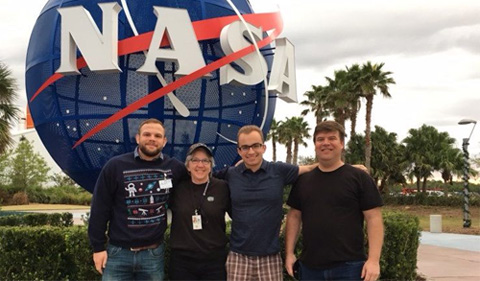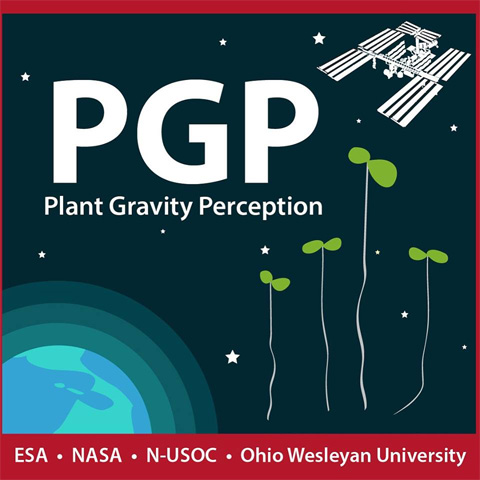
From left, OHIO grad student Alex Meyers, OHIO Professor of Environmental and Plant Biology Sarah Wyatt, technician Nathan Madonich, and Ohio Wesleyan Professor Chris Wolverton.
After about 140 days on the International Space Station (and more than 2,000 trips around the Earth), Alexander Meyers’ plants caught a ride home on the Dragon capsule Saturday morning, May 5.
“The capsule splashed down off the coast of Baja, and after retrieval and some brief inspection and handling from the folks at NASA, our brave little spacebabies will be transported back to us here at Ohio University,” says Meyers, a doctoral student in Environmental & Plant Biology and Molecular & Cellular Biology.
“Each one of the more than 1,200 seedlings needs to be dissected and their RNA extracted for analysis, so the PGP team has a busy and exciting couple months ahead!” Meyers says.
Meyers research is part of an EMCS-PGP (European Modular Cultivation System-Plant Gravity Perception) experiment with Ohio Wesleyan University in which seedlings were grown aboard the International Space Station to examine the cellular and molecular mechanisms that govern gravity sensing and response in plants.
Meyers will do all of the tissue processing, RNA extractions, and sequencing analysis in the lab with his adviser, Dr. Sarah Wyatt, Ohio University Professor of Environmental & Plant Biology. Ohio Wesleyan Professor Chris Wolverton is the lead PI on the project.
NASA writes about the project in a March 21 article headlined “Rooting for Answers: Simulating G-Force to Test Plant Gravity Perception in Mustard Seedlings.”
When plants on Earth search for nutrients and water, what drives their direction? Very simply, gravitational force helps them find the easiest path to the substances they need to grow and thrive. What happens if gravity is no longer part of the equation?
Botanists from Ohio Weslyan University leverage the microgravity environment of the International Space Station to study root growth behaviors and sensory systems in an investigation known as Gravity Perception Systems (Plant Gravity Perception). The researchers look for adaptability to microgravity and measure overall sensitivity to simulated gravity for two strains of mustard seedlings, including Arabidopsis thaliana Wild Type and a starchless genetic variant. Within the wild type, starch acts like a weight, falling within the root tips and driving them toward the Earth.
As the lead investigator for Plant Gravity Perception, botanist Chris Wolverton describes the investigation’s central question: “We want to know – what’s the least amount of gravity plants can detect to cause the falling of heavy [starchy] bodies in their cells?”
The study exposes both strains to incremental amounts of gravity ranging from four one thousandths or 0.004G – all the way up to one G. By comparison, gravitational force experienced on Earth is a constant one G.
Why include two types of seedlings? While exact thresholds for starchy strains are poorly understood, response mechanisms for starchless genetic variants are even more of a mystery.
Read more in the NASA article.
Follow Meyers’ work on his Facebook page.
















Comments